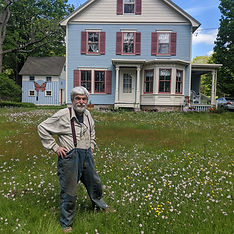Rethink Your Lawn
How?
-
Mow less frequently—only every 2-3 weeks
-
"Join the No Mow May movement (check your town blight ordinance about meadow restrictions)”
-
Reduce the size by adding shrubs, trees or a pollinator garden or clover!
-
Let part of your yard go natural. Wild flowers will likely appear. Create a mini-meadow
-
Avoid Pesticides
-
Test your soil to see what, if any, fertilizer you need, and go organic
-
Leave the leaves
-
Go Electric!
-
Allow for some dirt patches
-
Provide a fresh water source


Why are Lawns Causing a Problem?
-
They provide little to no habitat
-
They add fertilizers and toxins from 70 million pounds of pesticides a year to wetlands, streams and rivers & the Sound
-
Their root systems are too shallow to effectively filter stormwater runoff
-
Homeowners typically use 10 times the amount of pesticides and fertilizers per acre on their lawns than farmers do on crops

Lawns Use Tons of Water
-
In lower Fairfield County, 40% of water is used outdoors, and in the summer that number jumps to 70%, according to Aquarion Water Company
-
Nationally, lawns suck up 9 billion gallons of water per day, according to the EPA


Loss of Plant Diversity: America's biggest crop is not what you think!

Over 40 million acres of land in the continental US has some form of lawn on it. --Business Insider, February 19, 20
Convert your Lawn to a Meadow
Converting some or all of your lawn to woods or meadow creates a natural habitat for pollinators by adding diversity and interest to your backyard. In addition, it reduces the time you spend mowing and avoids the problems listed above. A diverse array of native trees, shrubs, perennial flowers, and warm season grasses are much better than turf grass for keeping soil and nutrients in place.
The first step to a lawn becoming a meadow is to stop the weekly mowing. Next you should pay attention to what plants are already there and remove any problem invasive species. If you already have bare patches between the grass (common in dry or shady lawns), you can immediately start planting small plants or scratch in some seeds, ideally in early spring or fall. Mow a meandering path through the area to invite you out in the space once the grass and other plants grow taller.
Lawn grasses can also be killed without herbicides using a technique called soil solarization. The entire lawn is covered with black plastic for 3 months – the heat kills the grass. You will then have a weed free area where you can rake and sow seeds or plant small plants in the dead turf. Sheet mulching is another effective technique. Read more about these methods in the Primer for the ecological gardener.
To learn more about how to convert your lawn to a meadow, please check out the following links:



Take the NO MOW MAY Challenge!

Let your green lawn turn into a riot of color with buttercups, clover, dandelions and daisies that will offer much-needed food for our beleaguered bees and butterflies who are hungry after a long winter.
That’s right—Do Nothing! Leave your mower in the garage until June. Every flower counts when it comes to providing a meal for pollinators, so it makes sense that cutting your lawn in early spring, when not many flowers are blooming yet, is not the best thing to do.
Understandably, if this is your first time it may be hard to get comfortable with a bit of messiness. Here’s a suggestion: don’t go “all the way.” Give your lawn a partial haircut instead of a full buzz cut by leaving islands or streams of lawn untouched by the mower where the wildflowers can bloom. Try mowing wide paths so you can walk around, watch the activity and enjoy the changing shapes and colors. Have these paths lead to a bench, a birdbath, a statue, or a big pot of flowers. If you’re worried about what the neighbors will say, mow a buffer along the edges and along your driveway and walkways to show the new look is intentional.
No Mow May saves time, saves money, provides for quiet relaxation, and eliminates noise and air pollution (the EPA attributes 5% of U.S. air pollution to mowers). Natural landscapes attract more bird species providing a chance for birdwatching, and they offer opportunities for photography, painting, or simply observing our native wildflowers and the pollinators that flock to them.
(Note: Please Check Your Town Blight Ordinance about Meadow Restrictions.
Here's how one Pollinator Pathway group challenged and updated their city's blight ordinance to allow managed meadows. )




